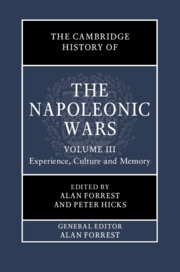Book contents
- The Cambridge History of the Napoleonic Wars
- The Cambridge History of the Napoleonic Wars
- The Cambridge History of the Napoleonic Wars
- Copyright page
- Contents
- Figures
- Maps
- Contributors to Volume III
- Introduction to Volume III
- Part I The Experience of War
- Part II The Experience of Imperial Rule
- Part III War, Culture and Memory
- 12 Memoirs and the Communication of Memory
- 13 Festivals, Ceremonies and Public Commemorations
- 14 The Portrayal of Heroism
- 15 The Fine Arts and the Napoleonic Wars
- 16 Poets and Novelists: Writing the Memory of War
- 17 Political Keyboard Music in Revolutionary and Napoleonic France: ‘The Battle’
- 18 The Napoleonic Wars in Caricature
- 19 The Napoleonic Wars in European Cinema
- 20 Nostalgia, or a Ruin with a View
- Part IV The Aftermath and Legacy of the Wars
- Bibliographic Essays
- Index
17 - Political Keyboard Music in Revolutionary and Napoleonic France: ‘The Battle’
from Part III - War, Culture and Memory
Published online by Cambridge University Press: 05 August 2022
- The Cambridge History of the Napoleonic Wars
- The Cambridge History of the Napoleonic Wars
- The Cambridge History of the Napoleonic Wars
- Copyright page
- Contents
- Figures
- Maps
- Contributors to Volume III
- Introduction to Volume III
- Part I The Experience of War
- Part II The Experience of Imperial Rule
- Part III War, Culture and Memory
- 12 Memoirs and the Communication of Memory
- 13 Festivals, Ceremonies and Public Commemorations
- 14 The Portrayal of Heroism
- 15 The Fine Arts and the Napoleonic Wars
- 16 Poets and Novelists: Writing the Memory of War
- 17 Political Keyboard Music in Revolutionary and Napoleonic France: ‘The Battle’
- 18 The Napoleonic Wars in Caricature
- 19 The Napoleonic Wars in European Cinema
- 20 Nostalgia, or a Ruin with a View
- Part IV The Aftermath and Legacy of the Wars
- Bibliographic Essays
- Index
Summary
As has often been mentioned in these volumes, experience of war was the overriding common denominator for people living in Europe in the period from 1789 to 1815. Not surprisingly, a popular genre in the music of the period also mirrors (and acts as a prism for) this protracted period of warfare. Two accidents accompanied this: first, the advent of the new, relatively affordable keyboard instrument, expressive par excellence, the fortepiano, which (unlike the harpsichord) could play both loud AND soft (as the name implied); and second, the growth in the interest in music, an interest shared across all social classes. Add to this mix a taste for sublime events expressing strong emotions (firework displays, balloon ascents, violent storms, waterfalls …), and the terrain was ready for the fad in France for descriptive music in general and the ‘pièce militaire et historique’ or musical ‘bataille’ for fortepiano in particular. The subject has been systematically rejected as worthy of study by writers on music history, both at the time and now, because this sort of music was deemed ‘fatuous’, written for an unmusical amateur musician, mostly female.1 But, so popular were these fortepiano battle pieces composed at the end of the eighteenth century that they were still being performed at the end of the nineteenth. This form of ‘political’ music had an influence way beyond its supposed musical shortcomings, bringing the battle into the drawing room. This essay charts the rise of the programmatic keyboard battle piece, with its specific (and novel) baggage of accompanying texts, and its presence in French home music, though it should be noted that the same phenomenon could be charted in Britain and Germany.
- Type
- Chapter
- Information
- The Cambridge History of the Napoleonic Wars , pp. 347 - 372Publisher: Cambridge University PressPrint publication year: 2022

